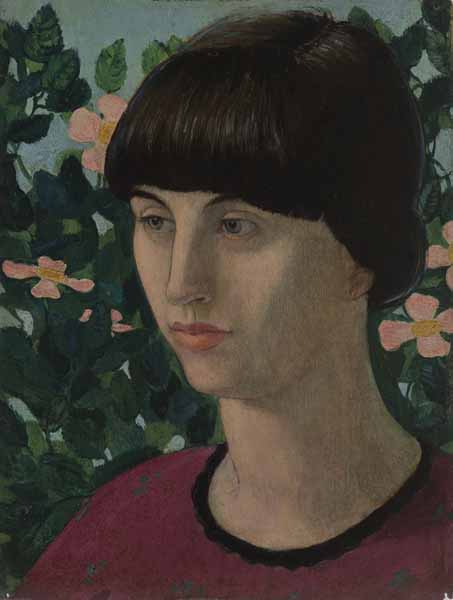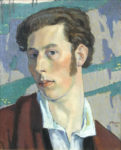
Adrian Paul Allinson
British, 1890–1959
Ruth, 1912 ca.
oil on canvas
12 ½ × 9 ½ in.
SBMA, Gift of Mary and Will Richeson, Jr.
1997.71.4

Self-Portrait, Adrian Allison
COMMENTS
Strong, clean pattern, as evinced in this portrait, painted around 1912, was to become the outstanding hallmark of Adrian Allinson’s painting throughout his life, whether figure, landscape, or still life. Allinson was a complex character, son of a freethinking vegetarian North Country English doctor and a Polish Jewish mother, herself the grandniece of the American women’s rights champion Ernestine Rose. His father was expelled from the medical profession for “non-medical practices”— the advocacy of the prevention of disease through diet—prior to founding a bakery that still carries the family name. Adrian began studies in medicine at the Middlesex Hospital before switching to art and entering the Slade School, London University.
The Slade at that time was dominated by the irascible, but brilliant professor of drawing Henry Tonks, who described the years immediately prior to the outbreak of World War I as a “crisis of brilliance.”
Allinson’s fellow students included Britain’s most talented artists of the first half of the 20th century: Stanley Spencer, Mark Gertler, C.R.W. Nevinson, David Bomberg, and Edward Wadsworth among them. Gertler, Nevinson, Wadsworth, and Allinson himself were celebrated in 1912 by another fellow student—John Currie, who committed suicide in 1914 after shooting his mistress—along with the proprietor of a Soho café, in a seminal group portrait, Some Later Primitives and Madame Tisceron.
Allinson never fulfilled his full talent as a painter, his wide interests leading him to dissipate his energies designing sets and costumes for Sir Thomas Beecham’s opera company, drawing caricatures for the press, studying direct carving and pottery, as well as pursuing his musical interests. His manuscript autobiography, with annotations by the novelist Dorothy Richardson, whose portrait he painted, is preserved with her papers in the Special Collections Department of the McFarlin Library, University of Tulsa, Oklahoma.
—Peyton Skipwith
Independent Scholar
75 in 25 Important Acquisitions at SBMA 1990-2015
2016
SBMA CURATORIAL LABELS
Allinson, the eldest son of an English doctor and his Jewish Polish wife was one of a small group of highly talented pupils at London’s Slade School of Fine Art shortly before the outbreak of World War I, along with Stanley Spencer, Mark Gertler, C.R.W. Nevinson, Paul Nash and Edward Wadsworth. Henry Tonks, the Slade Professor, later referred to this period as a “crisis of brilliance.”
Of Anglo-Polish parentage, Allinson had an exotic streak that led him to spread his talents widely as a caricaturist, stage designer, stone carver, potter, and musician; he also skied for England. Entering the Slade after a brief spell studying medicine at Middlesex Hospital, Allinson immediately teamed up with Nevinson, Mark Gertler, Edward Wadsworth and David Sassoon. His early portrait studies, such as Ruth, with their hard-edged quattrocento realism, have a strong affinity with Gertler’s work of the period. This is the earliest of the six paintings by Allinson at Santa Barbara, and the only one that shows his affinity with the “neo-primitives”, as they were dubbed.
British Modernism Whistler to WWII
2016
